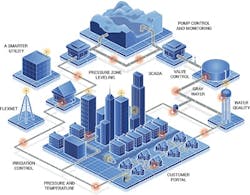How To: Leak Detection: Starting Up a Smart Water Network
About the author:
Dan Pinney is global director of water marketing for Sensus. Pinney can be reached at [email protected].
One-third of utilities around the globe report a loss of more than 40% of clean water due to leaks.
Smart water networks address this issue. With cohesive communication capabilities and massive amounts of real-time data, smart water networks enable utilities to identify leaks, better serve customers and conserve water.
A smart water network is an integrated set of products, solutions and systems that enable utilities to:
- Monitor and diagnose problems remotely;
- Prioritize and manage maintenance issues; and
- Use data to optimize all aspects of a water distribution network.
To avoid missing an opportunity to improve operational efficiency, utilities should follow these steps to water and revenue conservation with a smart water network:
1. Determine your needs. It is important to identify exactly what you need when implementing smart technology. Are you looking to only monitor for leaks or do you also want to send direct messages to customers, alerting them to heavy usage? Or perhaps you want a long-lasting technology to lead you into the future. Once you determine what you need, you can select the technology best suited for you.
2. Select your technology. As you shop for a smart water network, make sure your selection is sustainable, intelligent, reliable and customizable.
A sustainable communication network needs to meet your needs today and in the future. Consider a multi-application network that is scalable to support other technology in the future. This consideration does not just impact utilities—the right network can be scaled to address other needs within a city, such as lighting.
Intelligence is equally important. The influx of data from a smart water network can overwhelm many utilities. The right network offers alarms and alerts to streamline data and provide exactly the information a utility requires to make decisions.
It also is vital to ensure that your smart water network will last for many years to come. Communications systems can become obsolete after just a few years, so make certain you select a dependable, upgradeable, long-lasting technology.
Lastly, take customization into consideration. Like all utilities, your organization is unique, so your smart water network solution must be unique too. When selecting a network, confirm it can be customized to suit your needs.
3. Plan your deployment. Once you select your technology, begin putting it to use. Follow these deployment steps:
- Pilot: Take this time to get used to the new solution in a small area. Familiarize yourself with the remote monitoring and control, alert communication and leak detection capabilities.
- Expanded test: Once you become familiar with your smart water network’s capabilities, expand the pilot to a larger test area. This will help you get accustomed to increased data before expanding to include your entire territory.
- Rollout: When ready, begin rolling out your technology by zone to the remaining areas of your territory.
4. Make the most of your data. Now that your smart water network is in full operation, turn your data into actionable insights by doing the following:
- Collect the data: You must prioritize which issues can be solved with data and gather the data accordingly. For instance, you can combine advanced metering infrastructure data and SCADA data to conduct a distribution loss examination. If water losses in the network are problematic, data collection can help solve them.
- Analyze the data: Begin your analysis by determining your biggest challenge, then analyze the data surrounding it. If water loss is a major issue, examine both your usage data and your customers’ to pinpoint ongoing water use and thereby identify and stop leaks.
- Convert analysis into actionable insights: Analyzing data enables your utility to take action on any detected issues. For example, you can monitor your customers’ water usage habits and inform users on their consumption through routine usage alerts. This not only helps you conserve water, but it improves customer satisfaction by alerting them to heavy usage before their bill arrives.
Water utilities that implement a smart water network will:
- Improve conservation: With a smart water network’s monitoring capabilities, utilities can account for every drop of water that passes through their systems.
- Enhance customer service: Utilities can use collected data to provide customers with water consumption information down to the hour and with charts and graphs, which can be helpful in identifying high-usage activities and leaks.
- Increase communication: Smart water networks make it possible for utilities to break down barriers between them, their customers, other public service providers and government counterparts. Shared data helps cities and utilities better forecast issues in their infrastructure.
Download: Here
